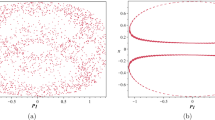Abstract
The periodic solutions for the Hamiltonian function governing the sextic galactic potential function in accordance with two different methods are investigated. The first method is applied using the averaging theory of first order. The sufficient conditions on the parameters for the stability are given and analyzed. The numerical examples of families of periodic orbits are introduced. Meanwhile, the second method is presented using Lyapunov’s theorem for the holomorphic integral, where the periodic solutions depend on the type of the equilibrium points.






Similar content being viewed by others
References
Ablowitz, M.J., Ramani, A., Segur, H.: A connection between nonlinear evaluation equations and ordinary differential equations of P-type. J. Math. Phys. 21, 715–721 (1980)
Arnold, V.I., Kozlov, V.V., Neishtadt, A.: Dynamical Systems III. Mathematical Aspects of Classical and Celestial Mechanics (1993)
Arnold, V.I., Kozlov, V.V., Neishtadt, A.: Mathematical Aspects of Classical and Celestial Mechanics. Springer, Berlin (2007)
Bogoliubov, N., Mitropolsky, Y.: Asymptotic Methods in the Theory of Nonlinear Oscillations. Gordon and Breach, New York (1961)
Buică, A., Llibre, J.: Averaging methods for finding periodic orbits via Brouwer degree. Bull. Sci. Math. 128(1), 7–22 (2004)
Carrasco-Olivera, D., Uribe, M., Vidal, C.: Periodic orbits associated to Hamiltonian functions of degree four. J. Nonlinear Math. Phys. 21(3), 336–356 (2014)
Contopoulos, G., Polymilis, C.: Approximations of the 3-particle Toda lattice. Physica D 24(1–3), 328–342 (1987)
Davies, K.T., Huston, T.E., Baranger, M.: Calculations of periodic trajectories for the Hénon–Heiles Hamiltonian using the monodromy method. Chaos 2, 215–224 (1992)
El-Dessoky, M.M., Elmandouh, A.A., Hobiny, A.: Periodic orbits of the generalized Friedmann-Robertson-Walker potential in galactic dynamics in a rotating reference frame. AIP Adv. 7, 035021 (2017)
El-Sabaa, F.: About the periodic solution of Kovaleveskaya’s top by using Liapunov’s method. J. Univ. Kuwait, Sci. 16, 21–27 (1989)
El-Sabaa, F.: Periodic solutions and their stability for the problem of gyrostat. Astrophys. Space Sci. 183, 199–213 (1991)
El-Sabaa, F.: About the periodic solutions of a rigid body in a central Newtonian field. Celest. Mech. Dyn. Astron. 55, 323–330 (1993)
El-Sabaa, F., Sherief, H.: On the galactic motion. Celest. Mech. Dyn. Astron. 49, 233–247 (1990a)
El-Sabaa, F., Sherief, H.: Periodic orbits of galactic motion. Astrophys. Space Sci. 167, 305–315 (1990b)
Fatou, P.: Sur le mouvement d’un système soumis à des forces à courte période. Bull. Soc. Math. Fr. 56, 98–139 (1928)
Jiménez-Lara, L., Llibre, J.: Periodic orbits and non-integrability of generalized classical Yang-Mills Hamiltonian systems. J. Math. Phys. 52, 032901 (2011)
Krylov, N., Bogoliubov, N.: Introduction to non-linear mechanics (in Russian) Patent No. 1, Kiev (1937)
Llibre, J., Jiménez-Lara, L.: Periodic orbits and non-integrability of Hénon–Heiles systems. J. Phys. A, Math. Theor. 44, 205103 (2011)
Llibre, J., Makhlouf, A.: Periodic orbits of the generalized Friedmann-Robertson-Walker Hamiltonian systems. Astrophys. Space Sci. 344, 45–50 (2013)
Lyapunov, A.M.: General Problem of Stability of Motion. Collected Works, vol. 2. Izd. Akad. Nauk SSSR, Moscow (1956)
Maciejewski, A.J., Przybylska, M., Stachowiak, T., Szydlowski, M.: Global integrability of cosmological scalar fields. J. Phys. A, Math. Theor. 41, 465101 (2008)
Morales-Ruiz, J.J., Ramis, J.-P., Simo, C.: Integrability of Hamiltonian systems and differential Galois groups of higher variational equations. Ann. Sci. Éc. Norm. Supér. 40, 845–884 (2007)
Ortega, A.C.: Periodic orbits of mechanical systems with homogeneous polynomial terms of degree five. Astrophys. Space Sci. 361, 1–8 (2016)
Ozaki, J., Kurosaki, S.: Periodic orbits of Hénon Heiles Hamiltonian: bifurcation phenomenon. Prog. Theor. Phys. 95, 519–529 (1996)
Pucacco, G., Boccaletti, D., Belmonte, C.: Quantitative predictions with detuned normal forms. Celest. Mech. Dyn. Astron. 102, 163–176 (2008)
Ramani, A., Grammaticos, B., Bountis, T.: The Painlevé property and singularity analysis of integrable and non-integrable systems. Phys. Rep. 180, 159–245 (1989)
Toda, M.: Vibration of a chain with nonlinear interaction. J. Phys. Soc. Jpn. 22, 431–436 (1967)
Uribe, M., Quispe, M.: Existence and stability of periodic orbits for a Hamiltonian system with homogeneous potential of degree five. Differ. Equ. Dyn. Syst. (2020). https://doi.org/10.1007/s12591-020-00526-8
Verhulst, F.: Differential Equations and Dynamical Systems. Henri Poincaré, pp. 109–177. Springer, Berlin (2012)
Yehia, H.M.: On periodic, almost stationary motions of a rigid body about a fixed point. J. Appl. Math. Mech. 41, 556–558 (1977)
Zakharov, V.E., Ivanov, M.F., Shur, L.N.: On anomalously slow stochastization in certain two-dimensional models of field theory. Zh. Èksp. Teor. Fiz. Lett. 30, 39–44 (1979)
Ziglin, S.L.V.: Branching of solutions and the nonexistence of first integrals in Hamiltonian mechanics. II. Funct. Anal. Appl. 17, 6–17 (1983)
Acknowledgement
The authors would like to thank the anonymous referee for their comments which substantially improved the presentation of their paper.
Author information
Authors and Affiliations
Corresponding author
Additional information
Publisher’s Note
Springer Nature remains neutral with regard to jurisdictional claims in published maps and institutional affiliations.
Appendices
Appendix 1
Appendix 2
Rights and permissions
About this article
Cite this article
El-Sabaa, F.M., Amer, T.S., Gad, H.M. et al. Existence of periodic solutions and their stability for a sextic galactic potential function. Astrophys Space Sci 366, 74 (2021). https://doi.org/10.1007/s10509-021-03981-z
Received:
Accepted:
Published:
DOI: https://doi.org/10.1007/s10509-021-03981-z



